
Students will learn about the attack on Pearl Harbor and the US response of the Pearl Harbor Day observance.
- Subject:
- English Language Arts
- History
- World History
- Material Type:
- Activity/Lab
- Lesson
- Provider:
- Wyoming PBS
- Date Added:
- 09/17/2019

Students will learn about the attack on Pearl Harbor and the US response of the Pearl Harbor Day observance.
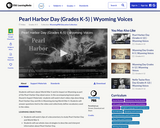
Students will learn about World War II and its impact on Wyoming as part of the Pearl Harbor Day observance.
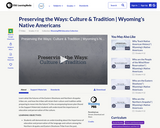
Learn what the futures of the Eastern Shoshone and Northern Arapaho tribes are, and how the tribes will retain their culture and tradition while preparing to move into the future? In the accompanying lesson plan (found in the Support Materials) students will understand the importance of education and perservation of the culture.
LEARNING OBJECTIVES:
Students will demonstrate an understanding about the importance of education and preservation of the language and culture among the Northern Arapaho and Eastern Shoshone Tribe from the past, present, and future.
Students will learn about the Federal Indian Policy to civilize Native Americans through the establishment of Native American Boarding Schools incorporating key vocabulary words.
Students will learn about how the practice of forced assimilation contributed to the diminished use of the Shoshone and Arapaho people’s lifestyle, languages, and traditions.
Students will discuss the development of Indian boarding schools in the United States and Wyoming.
Students will analyze the differences between the early educational experiences of the Native American and non-native students.
Students will examine the importance of education as a value that the Shoshone, Arapaho, and non-native communities share.
Students will consider how Native American students and non-native students can learn from each other to dispel the myths and stereotypes that exist in contemporary society.
Students will learn why oral traditions are important.
Students will understand why respect for elders is important in the tribe.
Students will gain an awareness of why traditional dancing and singing is important to traditions and culture.
Students will explore the significance of the buffalo to the Shoshone people living on the Wind River Reservation.
Students will learn that through traditional concepts of understanding, the Shoshone people, as well as many other Plains tribes, were able to survive through their sustenance on the buffalo.
Students will discuss the relationship that Native American people have with the buffalo (i.e., spiritual, sustenance, etc.) and how oral traditions play a critical role in the preservation of Native ways of knowing.

In this lesson, students will watch video #6 - "Preserving the Ways: Culture & Tradition." In the
previous videos, students were introduced and learned about the establishment of the Wind
River Reservation, why Native American History should be taught, the Northern Arapaho Tribe,
the Eastern Shoshone Tribe, and tribal government. This next video focuses on the importance
of education amongst the two tribes yet realizing the need to stay connected to their culture and
traditions. After viewing the video, students will create an arts and craft project (dreamcatcher),
write a"I am" poem, and participate in one of many social dances amongst all tribes across the
Nation.
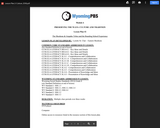
Native American history has often been shared through a westernized lens. As a result, an
accurate depiction of the events that occurred between the early European settlers and indigenous
peoples are limited to only one perspective.
This lesson plan will allow learners from diverse backgrounds the opportunity to explore the
federal Indian policies discussed in Video Module 6 - Preserving The Ways, Culture and
Traditions.
In order to understand the contemporary issues that the Shoshone and Arapaho people face, it is
important to gain a perspective of the underlying factors that contribute to these issues.

In this lesson students will learn about the Arapaho tribe on the Wind River Reservation and why
it is important to retain their culture through history, traditions, songs, ceremonies, dances,
language (revitalization).

Students will analyze the information provided in the video and discuss the topics. Students will
also identify conflicting information of the same topic and identify their position, why they
agree/disagree with the topic, and discuss a solution. In this case, brucellosis is discussed.
Through research, students should be able to develop their own perspective based on facts and
information provided in the video.
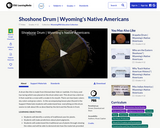
A drum like this is made from thinned deer hide or rawhide. It is fancy and has lacing which was placed on the drum when wet. This drum has a bird on it that could be a crane with a snake in its mouth. There are two basic colors: sky colors and grass colors. In the accompanying lesson plan (found in the Support Materials) students will understand how everything on this drum seems to talk about life as described by the bird and the florals in front.
LEARNING OBJECTIVES:
Students will identify a variety of traditional uses for plants.
Students will make predictions about plant pigments.
Students will understand the traditional use of plants through viewing the video and will be able to demonstrate how the materials provided by nature and animals allowed the Shoshone to create items used in everyday life.

In the accompanying lesson plan (found in the Support Materials) students will gain an understanding of the Shoshone tribe while learning about the Shoshone Parfleche from the WyomingPBS video.
LEARNING OBJECTIVES:
students will write 3-4 sentences stating/explaining how the Shoshone Parfleche is used.
Students will create an individual parfleche, designed with a line of symmetry, the use of a meter stick for specific measurements and the ability to use creativity to choose their own designs.
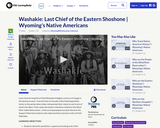
Learn how the long life of Chief Washakie bridged a century of change in the American west—from the time of nomadic tribes following buffalo herds, to the period when tribes relinquished their claims to vast tracts of land in the West. That's when the Eastern Shoshone settled on the Wind River Indian Reservation. In the accompanying lesson plan (found in the Support Materials) students will understand the character traits of Chief Washakie.
LEARNING OBJECTIVES:
Students will write and deliver a speech pretending to be Chief Washakie talking to the people of the 21st Century.
Students will learn character traits and qualities and describe every individual and determine life choices for all.
Students will practice identifying “cause and effect” with historical events based on character qualities.

Based on the Wyoming PBS program What’s in a Name, students will view episodes of the program to learn about how Wyoming towns got their names. In the introductory video Phil Roberts from the University of Wyoming introduces the PBS series entitled “Main Street Wyoming: What’s in a Name”. This introductory clip discusses how early explorers first named the rivers, streams, and mountain ranges and passes of Wyoming. Students will then work as a group to create a fictitious Wyoming town.
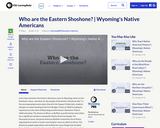
Learn how and when the Eastern Shoshone came to Wyoming, what are the Shoshone values, and what are the people of the Eastern Shoshone like? In the accompanying lessons plans (found in the Support Materials), students will gain an understanding of the Fort Bridger Treaty of 1868 including its importance to the state of Wyoming and the Eastern Shoshone Tribe in 1868 and today. The American Bison, or Buffalo as preferred by most tribes, has a significant existence among the Native American people. For thousands of years, the great American Buffalo roamed the Great Plains, migrating from north to south, searching for areas on which to thrive. The Shoshone people depended on the buffalo for many things that included food, clothing, and shelter. Every part of the buffalo was used and provided for the people.
LEARNING OBJECTIVES:
Students will study (Highlight, paraphrase and report) the Treaty of 1868 between the Eastern Shoshone Tribe and the United States Government.
Students will learn about the Eastern Shoshone people through the use of research and technology.
Students will understand that the history of the Shoshone people in the Wind River Mountains dates back thousands of years.
Students will understand that the circle of life continues in a perpetual cycle and is passed on through oral tradition. These stories often taught a lesson to young people.
Students will understand the indigenous perspective of interconnectedness. Students will understand how bison populations were devastated by western expansion.
Students will learn how to construct, read, compare and analyze different population graphs.
Students will understand how the diets of the Shoshone people varied depending on the areas in which they lived.
Students will acquire knowledge of the Wind River Reservation communities and be able to identify these locations on a map.
Students will be able to further describe how their culture has shaped them.
Students will be able to define the concept of culture.
Students will be able to explain some of the attributes of culture.
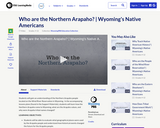
Students will gain an understanding of the Northern Arapaho people located on the Wind River Reservation in Wyoming. In the accompanying lessons plans (found in the Support Materials), students will learn how the Northern Arapaho come to Wyoming, what are the Arapaho values, and why were Arapaho tribal names changed?
LEARNING OBJECTIVES:
Students will be able to evaluate what geographical places were used by the Arapaho people and understand how historical events changed the future for the Arapaho people.
Students will compare and contrast between their social and ceremonial structures.
Students will understand the hierarchy of the Arapaho Tribe.
Students will analyze how their social and ceremonial structures contribute to their cultural identity.

This lesson will introduce the Arapaho social and ceremonial structures.

Place is very important on who a tribe is and understanding where the Arapaho lived is part of who the people are.
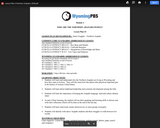
Students will demonstrate an understanding about the importance of heritage and preservation of
traditions and values of the Northern Arapaho Tribe that reside on the Wind River Reservation
located in Wyoming through viewing a video, completing a hands-on project, score a 70% or
higher on the shelter packet, and using mathematical measurements accurately.
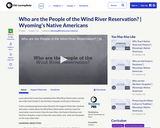
Learn about the treaty that estbalished the Wind River Reservation and the two tribes that inhabit it, the Northern Arapaho and Eastern Shoshone.
In the accompanying lesson plans (found in the Support Materials), students will watch a video about the Wind River Reservation and learn how the reservation came to exist, How the two tribes, the Eastern Shoshone and Northern Arapaho, come to share the reservation, and what are the people on the reservation like?
LEARNING OBJECTIVES:
Students will demonstrate an understanding about the 1868 Fort Bridger Treaty.
Students will create a map of the sacred sites fo the Shoshone and Araphaho Tribes.
Students will analyze the different pre and post reservation events for the Eastern Shoshone and Northern Arapaho tribes and evaluate why it is important for Wyoming state citizens to learn the history of the people of the Wind River Reservation
Students will gain an understanding of three spiritual sites in Wyoming.

In this lesson, students will view a video that contains information about the treaty that
established the Wind River Reservation and the two tribes that inhabit it, the Northern Arapaho
and Eastern Shoshone. After viewing the video and completing the worksheet, a field trip to one
of the sites mentioned in the video (if possible depending on location of school), students will
select a topic of interest to research for the three paragraph writing assignment and presentation.
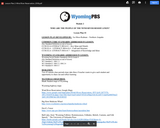
Students will use and analyze maps of Wyoming and create their own maps of the sites that are
sacred to the Shoshone and Arapaho Tribes. Students will build an understanding that Wyoming
has many sacred sites not only for the Shoshone and Arapaho but for neighboring tribes.
Students can also explore battles that took place in the State of Wyoming.

Students will work in expert groups to research important historical events for the Eastern
Shoshone and Northern Arapaho tribes. After completing research, the groups will present the
information to the class and place visuals on the timeline and determine which events had the
greatest impact on the people of the Wind River Reservation.